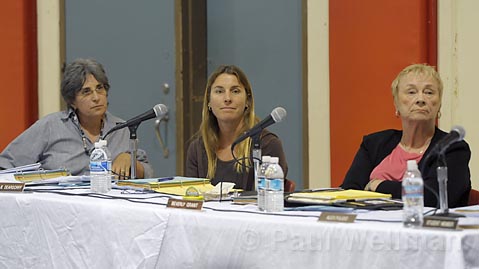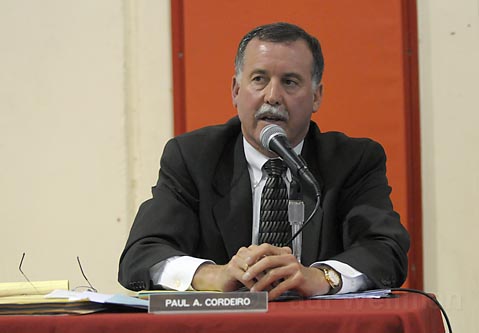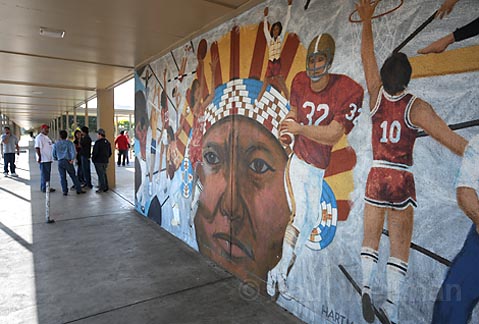Warriors Speak Up
Hundreds Pack Meeting to Discuss Carp High Symbol

The five-member school board of the Carpinteria Unified School District voted unanimously on May 13 to approve a motion to establish a board-appointed committee that would analyze and evaluate Carpinteria High’s use of Native American imagery and determine which emblems are offensive. Neither side of the dispute was awarded a clear victory at the board’s meeting, and many of the 900-plus attendees in the crowded gymnasium-the meeting was moved to accommodate the large number of attendees-expressed mixed feelings toward the ambiguous result.
The meeting marked the culmination of weeks of bitter words and outspoken opposition to the board’s 3-2 ruling on April 22 that all Native American imagery be removed from school property. Once again, throngs of Carpinteria Warriors, past and present, arrived to show their support for their beloved mascot.

After a suggestion from Superintendent Paul Cordeiro that a committee be formed in the fall to determine which emblems were derogatory, the board voted on the idea. The measure failed to pass because one member, Leslie Deardorff, abstained from voting, giving neither side the majority it needed to win.
Boardmember Amrita Salm said she felt that forming the committee in the fall was not timely enough and she altered the previous motion, stipulating that the committee would be board-appointed and would begin its work in the summer. This second measure passed unanimously after some modification as to exact dates.

What had been a peaceful forum for citizens to air their complaints to the board turned into a madhouse of shouting when the board members gave their reasoning for how they voted. The crowd grew rowdy when Beverly Grant began to defend her decision. Using a racial slur to make her point incensed the assembly and many stood up and turned their backs toward her while she spoke. Continuing to speak, Grant made allusions to the Holocaust and Nazism, further aggravating the assembly. Many of the parents and alumni present began to discuss efforts to have Grant recalled. “Never in my life have I heard the ‘N word in Carpinteria,” one parent said. Deardorff, who voted to ban the images on April 22, said, “We are here to educate children without racial bias.”
Before voting, the board heard dozens of citizens, both for and against the ban, pleading their respective cases. The overwhelming majority of the crowd was in favor of keeping the Native American images. Many felt that regardless of the board’s decision the issue was that the public was not consulted. Former school board member, Mike Damron, accused the board of putting too much emphasis on the opinion of one student, saying, “I guess the other 700 kids don’t matter.”
To raucous applause Craig Price, a Santa Barbara lawyer who serves as legal advisor to the board, said he felt there was no legal basis for the board to make their decision unless there was substantial evidence that the imagery created a hostile environment or prevented students from utilizing district services.
The assembly was less jubilant when Elias Cordero, the 15-year-old sophomore whose complaints began the controversy, stepped to the podium and told the board he felt the school emblem was wrong. “I’ve lived with the pain and happiness of being Chumash,” Cordero said as some in the crowd booed.
The issue of Native American ancestry was hotly discussed by many of the attendees. Some argued that the emblem depicted a member of a plains tribe, not a Chumash Indian, and therefore was not offensive to the Chumash culture. Tom Macias, a Carpinteria High senior, said, “Chumash isn’t the only Native American in our country.”
Melinda Powell responded to arguments that the images were symbols of honor and courage not of mockery saying, “I’m surprised that people who aren’t Native American feel they can speak for Native Americans when Native Americans say it is offensive.”

Others sought to discredit Cordeiro and other Native American speakers by speculating about their Chumash or Native heritage. “Just because you stand up at this mike and say you’re Native American, doesn’t mean you are Native American,” said Damron, who is also an alumni and the booster club president.
To members in support of the board’s original decision, such as Monique Sonoquie, a Chumash and Apache lecturer in the UCSB Department of Indigenous Studies, the issue does not revolve around Chumash Indians in particular but respect for all Native Americans and their images. “We’re people, not mascots,” she told the crowd.



